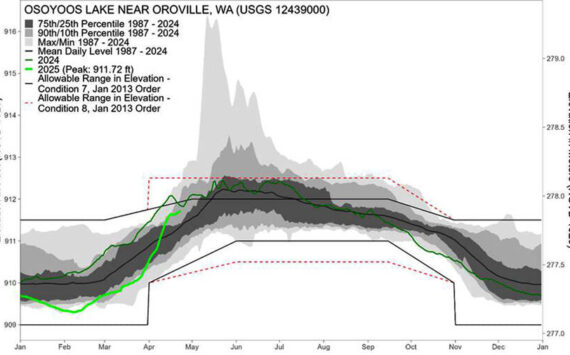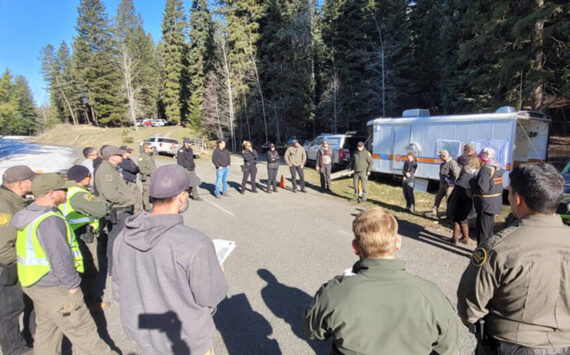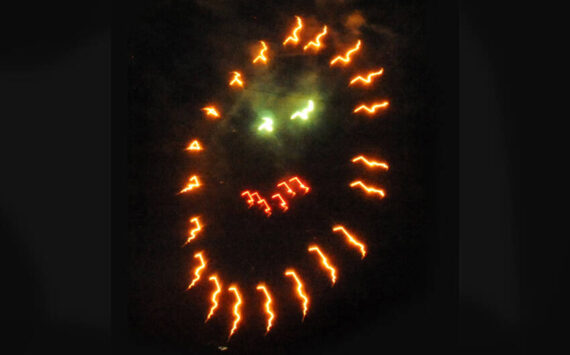OROVILLE – The state has approved a plan by the Okanogan County Noxious Weed Board to treat Eurasian Watermilfoil in Lake Osoyoos, although in a greatly reduced area then the board previously requested.
The state Department of Ecology has approved the weed control board’s plan to treat approximately 10 acres of isolated coves of Washington reaches of the international lake with the aquatic herbicide Triclopyr. The board originally applied to use the herbicide to treat 300 acres in an effort to eradicate the milfoil problem at the south end of the lake, which spans the U.S.-Canadian border.
Ecology’s approval comes after reviewing the comments and concerns raised by the B.C. Ministry of the Environment and others, according to Sandy Howard, a spokeswoman for Ecology’s Water Quality and Environmental Assessment programs.
“Ecology is confident that the lake treatments in compliance with the permit will protect water quality,” said Howard in a Sept. 9 agency press release.
Triclopyr is not approved for aquatic use in Canada and the Canadian-based Okanagan Basin Water Board (OBWB) voiced concerns about what affect the chemical will have on the their side of the shared lake. The B.C. Ministry of Environment sent a letter to the Weed Control Board asking it to investigate other options and to conduct consultation on both sides of he border. The OBWB also sent a letter asking the herbicide not be used adding that the use may represent a potential risk that could violate the Boundary Waters Treaty.
Osoyoos Mayor Stu Wells, who is also chairman of the OBWB said at the time, “We’re just saying that we don’t think they should be using that method in a shared area.”
However, several homeowners on the lake want something done about the problem because it has prevented many from using their beaches. Using the chemical is the least expensive treatment option.
“It is legal to treat milfoil in Washington waters under Washington’s permit, which is one of the most protective in the nation. For example, the permit requires timing treatments to avoid times when sensitive salmon species are present. The permit is based on a large body of credible scientific research,” said Howard in the release announcing Ecology’s decision.
“The Department of Ecology believes the Weed Board has put forth a plan that addresses concerns raised by British Columbia. Based on implementation of the board’s plan, we do not believe that treated water will get into B.C. reaches of the lake. Due to the lakes inlet and outlet, lake water flows to the south, further increasing protection of B.C. reaches of the lake from receiving lake treatment chemicals,” said Howard in the release.
Eurasian Milfoil is a non-native, invasive plant that forms dense mats of vegetation on the surface of lakes. These mats interfere with recreational activities such as swimming, fishing, water skiing and boating.
Ecology anticipates the weed control board to move ahead with lake treatment this season.
There used to be a state-funded program of mechanically treating the milfoil on the U.S. side, but that hasn’t taken place for a number of years. A spokesperson for the weed control board said there were five milfoil-related drowning deaths in the state last year and their first concern is safety.
Osoyoos Mayor Wells said the lakes are vital for drinking water, agriculture and tourism and he has concerns about chemically treating the milfoil.
The county weed control board says any negative impact to native plants from the herbicide has been short-term and if a subsurface injection is used drift outside the treatment area is unlikely.
Wells counters that herbicide treatment is not a permanent solution and claims chemical-free methods work just as well, although they are much more expensive. In Osoyoos rotatillers are used during the fall and winter to remove the roots of the plants in shallow areas. In the summer the milfoil is cut about two yards below the surface using harvesters.
Milfoil will be just one of the topics at the upcoming 2011 Osoyoos Lake Water Science Forum scheduled to take place at the Sonora Community Centre in Osoyoos Sept. 18 to 20.
According to Ecology’s website, Eurasian watermilfoil may have been introduced to the North American continent at Chesapeake Bay in the 1880s.
“By 1985, Eurasian watermilfoil had been found in 33 states, the District of Columbia and the Canadian provinces of British Columbia, Ontario, and Quebec. The first known record of Eurasian watermilfoil in Washington is from a 1965 specimen collected from Lake Meridian in King County. However, state officials first became aware of Eurasian watermilfoil as a problem plant in 1974 when Eurasian watermilfoil moved downstream from the Canadian Okanogan Lake Chain into Lake Osoyoos, despite government efforts to halt its downstream spread. From Osoyoos, Eurasian watermilfoil moved downstream into the Okanogan River and the Columbia River.”






